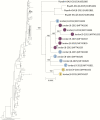Multihospital Outbreak of a Middle East Respiratory Syndrome Coronavirus Deletion Variant, Jordan: A Molecular, Serologic, and Epidemiologic Investigation
- PMID: 30294616
- PMCID: PMC5965092
- DOI: 10.1093/ofid/ofy095
Multihospital Outbreak of a Middle East Respiratory Syndrome Coronavirus Deletion Variant, Jordan: A Molecular, Serologic, and Epidemiologic Investigation
Abstract
Background: An outbreak of Middle East respiratory syndrome coronavirus (MERS-CoV) in Jordan in 2015 involved a variant virus that acquired distinctive deletions in the accessory open reading frames. We conducted a molecular and seroepidemiologic investigation to describe the deletion variant's transmission patterns and epidemiology.
Methods: We reviewed epidemiologic and medical chart data and analyzed viral genome sequences from respiratory specimens of MERS-CoV cases. In early 2016, sera and standardized interviews were obtained from MERS-CoV cases and their contacts. Sera were evaluated by nucleocapsid and spike protein enzyme immunoassays and microneutralization.
Results: Among 16 cases, 11 (69%) had health care exposure and 5 (31%) were relatives of a known case; 13 (81%) were symptomatic, and 7 (44%) died. Genome sequencing of MERS-CoV from 13 cases revealed 3 transmissible deletions associated with clinical illness during the outbreak. Deletion variant sequences were epidemiologically clustered and linked to a common transmission chain. Interviews and sera were collected from 2 surviving cases, 23 household contacts, and 278 health care contacts; 1 (50%) case, 2 (9%) household contacts, and 3 (1%) health care contacts tested seropositive.
Conclusions: The MERS-CoV deletion variants retained human-to-human transmissibility and caused clinical illness in infected persons despite accumulated mutations. Serology suggested limited transmission beyond that detected during the initial outbreak investigation.
Keywords: Jordan; MERS-CoV; Middle East respiratory syndrome; coronavirus; emerging infectious disease; genome deletion; outbreak investigation; sero-epidemiology.
Figures



References
-
- Arabi YM, Arifi AA, Balkhy HH, et al. . Clinical course and outcomes of critically ill patients with Middle East respiratory syndrome coronavirus infection. Ann Intern Med 2014; 160:389–97. - PubMed
-
- World Health Organization. Middle East respiratory syndrome coronavirus (MERS-CoV). Available at: http://www.who.int/emergencies/mers-cov/en/. Accessed 30 May 2017.
-
- Hijawi B, Abdallat M, Sayaydeh A, et al. . Novel coronavirus infections in Jordan, April 2012: epidemiological findings from a retrospective investigation. East Mediterr Health J 2013; 19(Suppl 1):S12–8. - PubMed
-
- World Health Organization. Global Alert and Response (GAR): Middle East respiratory syndrome coronavirus. Available at: http://www.who.int/csr/disease/coronavirus_infections/en. Accessed 16 May 2018.
LinkOut - more resources
Full Text Sources

